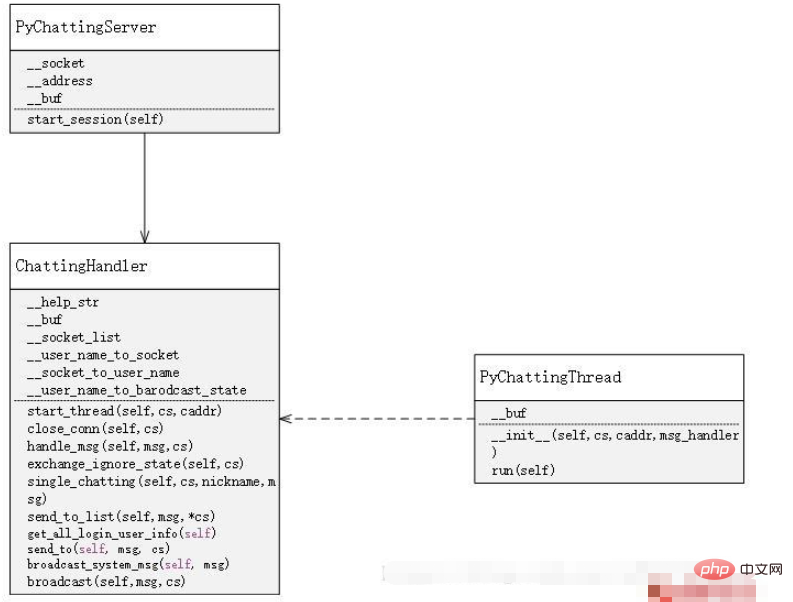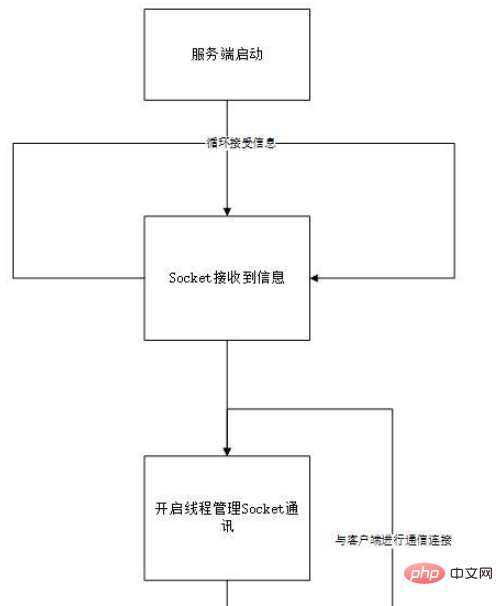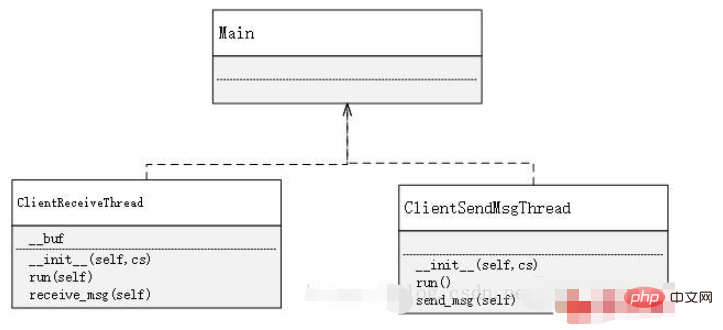Tutorial on writing a simple chat program in Python
May 08, 2023 pm 06:37 PMImplementation ideas
x01 Establishment of the server
First, on the server side, use socket to accept messages. Every time a socket request is accepted, a socket is opened. A new thread is used to manage the distribution and acceptance of messages. At the same time, there is a handler to manage all threads, thereby realizing the processing of various functions of the chat room
x02 Establishment of the client
The establishment of the client is much simpler than the server. The function of the client is only to send and receive messages, and to enter specific characters according to specific rules to achieve the use of different functions. Therefore, in On the client side, you only need to use two threads, one is dedicated to receiving messages, and the other is dedicated to sending messages. As for why not use one, that is because, if you only use one, then After receiving a message, the one that receives the message is in a blocked state before sending it. Similarly, the same is true for sending a message. If these two functions are implemented in one place, it will make it impossible to continuously send or receive messages.
Implementation method
Server-side implementation

import?json
import?threading
from?socket?import?*
from?time?import?ctime
class?PyChattingServer:
????__socket?=?socket(AF_INET,?SOCK_STREAM,?0)
????__address?=?('',?12231)
????__buf?=?1024
????def?__init__(self):
????????self.__socket.bind(self.__address)
????????self.__socket.listen(20)
????????self.__msg_handler?=?ChattingHandler()
????def?start_session(self):
????????print('等待客戶連接...\r\n')
????????try:
????????????while?True:
????????????????cs,?caddr?=?self.__socket.accept()
????????????????#?利用handler來管理線程,實現(xiàn)線程之間的socket的相互通信
????????????????self.__msg_handler.start_thread(cs,?caddr)
????????except?socket.error:
????????????pass
class?ChattingThread(threading.Thread):
????__buf?=?1024
????def?__init__(self,?cs,?caddr,?msg_handler):
????????super(ChattingThread,?self).__init__()
????????self.__cs?=?cs
????????self.__caddr?=?caddr
????????self.__msg_handler?=?msg_handler
????#?使用多線程管理會話
????def?run(self):
????????try:
????????????print('...連接來自于:',?self.__caddr)
????????????data?=?'歡迎你到來PY_CHATTING!請輸入你的很cooooool的昵稱(不能帶有空格喲`)\r\n'
????????????self.__cs.sendall(bytes(data,?'utf-8'))
????????????while?True:
????????????????data?=?self.__cs.recv(self.__buf).decode('utf-8')
????????????????if?not?data:
????????????????????break
????????????????self.__msg_handler.handle_msg(data,?self.__cs)
????????????????print(data)
????????except?socket.error?as?e:
????????????print(e.args)
????????????pass
????????finally:
????????????self.__msg_handler.close_conn(self.__cs)
????????????self.__cs.close()
class?ChattingHandler:
????__help_str?=?"[?SYSTEM?]\r\n"?\
?????????????????"輸入/ls,即可獲得所有登陸用戶信息\r\n"?\
?????????????????"輸入/h,即可獲得幫助\r\n"?\
?????????????????"輸入@用戶名?(注意用戶名后面的空格)+消息,即可發(fā)動單聊\r\n"?\
?????????????????"輸入/i,即可屏蔽群聊信息\r\n"?\
?????????????????"再次輸入/i,即可取消屏蔽\r\n"?\
?????????????????"所有首字符為/的信息都不會發(fā)送出去"
????__buf?=?1024
????__socket_list?=?[]
????__user_name_to_socket?=?{}
????__socket_to_user_name?=?{}
????__user_name_to_broadcast_state?=?{}
????def?start_thread(self,?cs,?caddr):
????????self.__socket_list.append(cs)
????????chat_thread?=?ChattingThread(cs,?caddr,?self)
????????chat_thread.start()
????def?close_conn(self,?cs):
????????if?cs?not?in?self.__socket_list:
????????????return
????????#?去除socket的記錄
????????nickname?=?"SOMEONE"
????????if?cs?in?self.__socket_list:
????????????self.__socket_list.remove(cs)
????????#?去除socket與username之間的映射關系
????????if?cs?in?self.__socket_to_user_name:
????????????nickname?=?self.__socket_to_user_name[cs]
????????????self.__user_name_to_socket.pop(self.__socket_to_user_name[cs])
????????????self.__socket_to_user_name.pop(cs)
????????????self.__user_name_to_broadcast_state.pop(nickname)
????????nickname?+=?"?"
????????#?廣播某玩家退出聊天室
????????self.broadcast_system_msg(nickname?+?"離開了PY_CHATTING")
????#?管理用戶輸入的信息
????def?handle_msg(self,?msg,?cs):
????????js?=?json.loads(msg)
????????if?js['type']?==?"login":
????????????if?js['msg']?not?in?self.__user_name_to_socket:
????????????????if?'?'?in?js['msg']:
????????????????????self.send_to(json.dumps({
????????????????????????'type':?'login',
????????????????????????'success':?False,
????????????????????????'msg':?'賬號不能夠帶有空格'
????????????????????}),?cs)
????????????????else:
????????????????????self.__user_name_to_socket[js['msg']]?=?cs
????????????????????self.__socket_to_user_name[cs]?=?js['msg']
????????????????????self.__user_name_to_broadcast_state[js['msg']]?=?True
????????????????????self.send_to(json.dumps({
????????????????????????'type':?'login',
????????????????????????'success':?True,
????????????????????????'msg':?'昵稱建立成功,輸入/ls可查看所有在線的人,輸入/help可以查看幫助(所有首字符為/的消息都不會發(fā)送)'
????????????????????}),?cs)
????????????????????#?廣播其他人,他已經進入聊天室
????????????????????self.broadcast_system_msg(js['msg']?+?"已經進入了聊天室")
????????????else:
????????????????self.send_to(json.dumps({
????????????????????'type':?'login',
????????????????????'success':?False,
????????????????????'msg':?'賬號已存在'
????????????????}),?cs)
????????#?若玩家處于屏蔽模式,則無法發(fā)送群聊消息
????????elif?js['type']?==?"broadcast":
????????????if?self.__user_name_to_broadcast_state[self.__socket_to_user_name[cs]]:
????????????????self.broadcast(js['msg'],?cs)
????????????else:
????????????????self.send_to(json.dumps({
????????????????????'type':?'broadcast',
????????????????????'msg':?'屏蔽模式下無法發(fā)送群聊信息'
????????????????}),?cs)
????????elif?js['type']?==?"ls":
????????????self.send_to(json.dumps({
????????????????'type':?'ls',
????????????????'msg':?self.get_all_login_user_info()
????????????}),?cs)
????????elif?js['type']?==?"help":
????????????self.send_to(json.dumps({
????????????????'type':?'help',
????????????????'msg':?self.__help_str
????????????}),?cs)
????????elif?js['type']?==?"sendto":
????????????self.single_chatting(cs,?js['nickname'],?js['msg'])
????????elif?js['type']?==?"ignore":
????????????self.exchange_ignore_state(cs)
????def?exchange_ignore_state(self,?cs):
????????if?cs?in?self.__socket_to_user_name:
????????????state?=?self.__user_name_to_broadcast_state[self.__socket_to_user_name[cs]]
????????????if?state:
????????????????state?=?False
????????????else:
????????????????state?=?True
????????????self.__user_name_to_broadcast_state.pop(self.__socket_to_user_name[cs])
????????????self.__user_name_to_broadcast_state[self.__socket_to_user_name[cs]]?=?state
????????????if?self.__user_name_to_broadcast_state[self.__socket_to_user_name[cs]]:
????????????????msg?=?"通常模式"
????????????else:
????????????????msg?=?"屏蔽模式"
????????????self.send_to(json.dumps({
????????????????'type':?'ignore',
????????????????'success':?True,
????????????????'msg':?'[TIME?:?%s]\r\n[?SYSTEM?]?:?%s\r\n'?%?(ctime(),?"模式切換成功,現(xiàn)在是"?+?msg)
????????????}),?cs)
????????else:
????????????self.send_to({
????????????????'type':?'ignore',
????????????????'success':?False,
????????????????'msg':?'切換失敗'
????????????},?cs)
????def?single_chatting(self,?cs,?nickname,?msg):
????????if?nickname?in?self.__user_name_to_socket:
????????????msg?=?'[TIME?:?%s]\r\n[?%s?CHATTING?TO?%s?]?:?%s\r\n'?%?(
????????????????ctime(),?self.__socket_to_user_name[cs],?nickname,?msg)
????????????self.send_to_list(json.dumps({
????????????????'type':?'single',
????????????????'msg':?msg
????????????}),?self.__user_name_to_socket[nickname],?cs)
????????else:
????????????self.send_to(json.dumps({
????????????????'type':?'single',
????????????????'msg':?'該用戶不存在'
????????????}),?cs)
????????print(nickname)
????def?send_to_list(self,?msg,?*cs):
????????for?i?in?range(len(cs)):
????????????self.send_to(msg,?cs[i])
????def?get_all_login_user_info(self):
????????login_list?=?"[?SYSTEM?]?ALIVE?USER?:?\r\n"
????????for?key?in?self.__socket_to_user_name:
????????????login_list?+=?self.__socket_to_user_name[key]?+?",\r\n"
????????return?login_list
????def?send_to(self,?msg,?cs):
????????if?cs?not?in?self.__socket_list:
????????????self.__socket_list.append(cs)
????????cs.sendall(bytes(msg,?'utf-8'))
????def?broadcast_system_msg(self,?msg):
????????data?=?'[TIME?:?%s]\r\n[?SYSTEM?]?:?%s\r\n'?%?(ctime(),?msg)
????????js?=?json.dumps({
????????????'type':?'system_msg',
????????????'msg':?data
????????})
????????#?屏蔽了群聊的玩家也可以獲得系統(tǒng)的群發(fā)信息
????????for?i?in?range(len(self.__socket_list)):
????????????if?self.__socket_list[i]?in?self.__socket_to_user_name:
????????????????self.__socket_list[i].sendall(bytes(js,?'utf-8'))
????def?broadcast(self,?msg,?cs):
????????data?=?'[TIME?:?%s]\r\n[%s]?:?%s\r\n'?%?(ctime(),?self.__socket_to_user_name[cs],?msg)
????????js?=?json.dumps({
????????????'type':?'broadcast',
????????????'msg':?data
????????})
????????#?沒有的登陸的玩家無法得知消息,屏蔽了群聊的玩家也沒辦法獲取信息
????????for?i?in?range(len(self.__socket_list)):
????????????if?self.__socket_list[i]?in?self.__socket_to_user_name?\
????????????????????and?self.__user_name_to_broadcast_state[self.__socket_to_user_name[self.__socket_list[i]]]:
????????????????self.__socket_list[i].sendall(bytes(js,?'utf-8'))
def?main():
????server?=?PyChattingServer()
????server.start_session()
main()
 Client-side implementation
Client-side implementation

import?json
import?threading
from?socket?import?*
is_login?=?False
is_broadcast?=?True
class?ClientReceiveThread(threading.Thread):
????__buf?=?1024
????def?__init__(self,?cs):
????????super(ClientReceiveThread,?self).__init__()
????????self.__cs?=?cs
????def?run(self):
????????self.receive_msg()
????def?receive_msg(self):
????????while?True:
????????????msg?=?self.__cs.recv(self.__buf).decode('utf-8')
????????????if?not?msg:
????????????????break
????????????js?=?json.loads(msg)
????????????if?js['type']?==?"login":
????????????????if?js['success']:
????????????????????global?is_login
????????????????????is_login?=?True
????????????????print(js['msg'])
????????????elif?js['type']?==?"ignore":
????????????????if?js['success']:
????????????????????global?is_broadcast
????????????????????if?is_broadcast:
????????????????????????is_broadcast?=?False
????????????????????else:
????????????????????????is_broadcast?=?True
????????????????print(js['msg'])
????????????else:
????????????????if?not?is_broadcast:
????????????????????print("[現(xiàn)在處于屏蔽模式]")
????????????????print(js['msg'])
class?ClientSendMsgThread(threading.Thread):
????def?__init__(self,?cs):
????????super(ClientSendMsgThread,?self).__init__()
????????self.__cs?=?cs
????def?run(self):
????????self.send_msg()
????#?根據不同的輸入格式來進行不同的聊天方式
????def?send_msg(self):
????????while?True:
????????????js?=?None
????????????msg?=?input()
????????????if?not?is_login:
????????????????js?=?json.dumps({
????????????????????'type':?'login',
????????????????????'msg':?msg
????????????????})
????????????elif?msg[0]?==?"@":
????????????????data?=?msg.split('?')
????????????????if?not?data:
????????????????????print("請重新輸入")
????????????????????break
????????????????nickname?=?data[0]
????????????????nickname?=?nickname.strip("@")
????????????????if?len(data)?==?1:
????????????????????data.append("?")
????????????????js?=?json.dumps({
????????????????????'type':?'sendto',
????????????????????'nickname':?nickname,
????????????????????'msg':?data[1]
????????????????})
????????????elif?msg?==?"/help":
????????????????js?=?json.dumps({
????????????????????'type':?'help',
????????????????????'msg':?None
????????????????})
????????????elif?msg?==?"/ls":
????????????????js?=?json.dumps({
????????????????????'type':?'ls',
????????????????????'msg':?None
????????????????})
????????????elif?msg?==?"/i":
????????????????js?=?json.dumps({
????????????????????'type':?'ignore',
????????????????????'msg':?None
????????????????})
????????????else:
????????????????if?msg[0]?!=?'/':
????????????????????js?=?json.dumps({
????????????????????????'type':?'broadcast',
????????????????????????'msg':?msg
????????????????????})
????????????if?js?is?not?None:
????????????????self.__cs.sendall(bytes(js,?'utf-8'))
def?main():
????buf?=?1024
????#?改變這個的地址,變成服務器的地址,那么只要部署到服務器上就可以全網使用了
????address?=?("127.0.0.1",?12231)
????cs?=?socket(AF_INET,?SOCK_STREAM,?0)
????cs.connect(address)
????data?=?cs.recv(buf).decode("utf-8")
????if?data:
????????print(data)
????receive_thread?=?ClientReceiveThread(cs)
????receive_thread.start()
????send_thread?=?ClientSendMsgThread(cs)
????send_thread.start()
????while?True:
????????pass
main()The above is the detailed content of Tutorial on writing a simple chat program in Python. For more information, please follow other related articles on the PHP Chinese website!

Hot AI Tools

Undress AI Tool
Undress images for free

Undresser.AI Undress
AI-powered app for creating realistic nude photos

AI Clothes Remover
Online AI tool for removing clothes from photos.

Clothoff.io
AI clothes remover

Video Face Swap
Swap faces in any video effortlessly with our completely free AI face swap tool!

Hot Article

Hot Tools

Notepad++7.3.1
Easy-to-use and free code editor

SublimeText3 Chinese version
Chinese version, very easy to use

Zend Studio 13.0.1
Powerful PHP integrated development environment

Dreamweaver CS6
Visual web development tools

SublimeText3 Mac version
God-level code editing software (SublimeText3)

Hot Topics
 How to use PHP combined with AI to achieve text error correction PHP syntax detection and optimization
Jul 25, 2025 pm 08:57 PM
How to use PHP combined with AI to achieve text error correction PHP syntax detection and optimization
Jul 25, 2025 pm 08:57 PM
To realize text error correction and syntax optimization with AI, you need to follow the following steps: 1. Select a suitable AI model or API, such as Baidu, Tencent API or open source NLP library; 2. Call the API through PHP's curl or Guzzle and process the return results; 3. Display error correction information in the application and allow users to choose whether to adopt it; 4. Use php-l and PHP_CodeSniffer for syntax detection and code optimization; 5. Continuously collect feedback and update the model or rules to improve the effect. When choosing AIAPI, focus on evaluating accuracy, response speed, price and support for PHP. Code optimization should follow PSR specifications, use cache reasonably, avoid circular queries, review code regularly, and use X
 PHP calls AI intelligent voice assistant PHP voice interaction system construction
Jul 25, 2025 pm 08:45 PM
PHP calls AI intelligent voice assistant PHP voice interaction system construction
Jul 25, 2025 pm 08:45 PM
User voice input is captured and sent to the PHP backend through the MediaRecorder API of the front-end JavaScript; 2. PHP saves the audio as a temporary file and calls STTAPI (such as Google or Baidu voice recognition) to convert it into text; 3. PHP sends the text to an AI service (such as OpenAIGPT) to obtain intelligent reply; 4. PHP then calls TTSAPI (such as Baidu or Google voice synthesis) to convert the reply to a voice file; 5. PHP streams the voice file back to the front-end to play, completing interaction. The entire process is dominated by PHP to ensure seamless connection between all links.
 Completed python blockbuster online viewing entrance python free finished website collection
Jul 23, 2025 pm 12:36 PM
Completed python blockbuster online viewing entrance python free finished website collection
Jul 23, 2025 pm 12:36 PM
This article has selected several top Python "finished" project websites and high-level "blockbuster" learning resource portals for you. Whether you are looking for development inspiration, observing and learning master-level source code, or systematically improving your practical capabilities, these platforms are not to be missed and can help you grow into a Python master quickly.
 Python for Quantum Machine Learning
Jul 21, 2025 am 02:48 AM
Python for Quantum Machine Learning
Jul 21, 2025 am 02:48 AM
To get started with quantum machine learning (QML), the preferred tool is Python, and libraries such as PennyLane, Qiskit, TensorFlowQuantum or PyTorchQuantum need to be installed; then familiarize yourself with the process by running examples, such as using PennyLane to build a quantum neural network; then implement the model according to the steps of data set preparation, data encoding, building parametric quantum circuits, classic optimizer training, etc.; in actual combat, you should avoid pursuing complex models from the beginning, paying attention to hardware limitations, adopting hybrid model structures, and continuously referring to the latest documents and official documents to follow up on development.
 How to use PHP to develop product recommendation module PHP recommendation algorithm and user behavior analysis
Jul 23, 2025 pm 07:00 PM
How to use PHP to develop product recommendation module PHP recommendation algorithm and user behavior analysis
Jul 23, 2025 pm 07:00 PM
To collect user behavior data, you need to record browsing, search, purchase and other information into the database through PHP, and clean and analyze it to explore interest preferences; 2. The selection of recommendation algorithms should be determined based on data characteristics: based on content, collaborative filtering, rules or mixed recommendations; 3. Collaborative filtering can be implemented in PHP to calculate user cosine similarity, select K nearest neighbors, weighted prediction scores and recommend high-scoring products; 4. Performance evaluation uses accuracy, recall, F1 value and CTR, conversion rate and verify the effect through A/B tests; 5. Cold start problems can be alleviated through product attributes, user registration information, popular recommendations and expert evaluations; 6. Performance optimization methods include cached recommendation results, asynchronous processing, distributed computing and SQL query optimization, thereby improving recommendation efficiency and user experience.
 How to join a list of strings in Python
Jul 18, 2025 am 02:15 AM
How to join a list of strings in Python
Jul 18, 2025 am 02:15 AM
In Python, the following points should be noted when merging strings using the join() method: 1. Use the str.join() method, the previous string is used as a linker when calling, and the iterable object in the brackets contains the string to be connected; 2. Make sure that the elements in the list are all strings, and if they contain non-string types, they need to be converted first; 3. When processing nested lists, you must flatten the structure before connecting.
 Python web scraping tutorial
Jul 21, 2025 am 02:39 AM
Python web scraping tutorial
Jul 21, 2025 am 02:39 AM
To master Python web crawlers, you need to grasp three core steps: 1. Use requests to initiate a request, obtain web page content through get method, pay attention to setting headers, handling exceptions, and complying with robots.txt; 2. Use BeautifulSoup or XPath to extract data. The former is suitable for simple parsing, while the latter is more flexible and suitable for complex structures; 3. Use Selenium to simulate browser operations for dynamic loading content. Although the speed is slow, it can cope with complex pages. You can also try to find a website API interface to improve efficiency.
 How to develop AI intelligent form system with PHP PHP intelligent form design and analysis
Jul 25, 2025 pm 05:54 PM
How to develop AI intelligent form system with PHP PHP intelligent form design and analysis
Jul 25, 2025 pm 05:54 PM
When choosing a suitable PHP framework, you need to consider comprehensively according to project needs: Laravel is suitable for rapid development and provides EloquentORM and Blade template engines, which are convenient for database operation and dynamic form rendering; Symfony is more flexible and suitable for complex systems; CodeIgniter is lightweight and suitable for simple applications with high performance requirements. 2. To ensure the accuracy of AI models, we need to start with high-quality data training, reasonable selection of evaluation indicators (such as accuracy, recall, F1 value), regular performance evaluation and model tuning, and ensure code quality through unit testing and integration testing, while continuously monitoring the input data to prevent data drift. 3. Many measures are required to protect user privacy: encrypt and store sensitive data (such as AES






